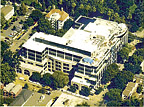
The system had to be quiet, reliable, and easily controlled with a wall-mounted thermostat and/or the building's electronic control system. It also had to have the ability to operate in a number of different modes (normal day and nighttime operations, along with a morning warm-up cycle). Many types of perimeter HVAC systems had been tried in the past, but none of the traditional methods seemed able to satisfy the stringent engineering requirements for this project.
"One of the biggest challenges we faced was coming up with a system that would fit within the limited underfloor space requirements," said Mark Vranicar, P.E., senior project manager with Critchfield. "Initially, we tried to get the floor raised to 18 inches, but the exterior of the building couldn't be changed, so we had to work with a 16-inch raised floor."
The firm decided to use Greenheck's variable-speed, energy efficient underfloor fan terminals (UFT). Only 168 UFTs with hot water heating coils were required to satisfy the perimeter zones of the building. The building was designed with a 16-in. raised floor height, and Vranicar selected the UFT Series 13 to accommodate the building's perimeter air needs.
Built-Up
Vranicar chose a built-up system as opposed to a standard AHU. The complex includes three built-up systems in three different sections of the building. Each built-up system consists of three connecting rooms: an intake/mixing air plenum room, a fan/supply air plenum room, and a return air plenum room. These rooms are used to control the amount and type of air that will be moved throughout the building.Two Greenheck centrifugal blowers were used to supply 63° to 65°F air down a duct chase that branches out to each floor. To keep a constant pressure in the supply air duct, the speed of the centrifugal blowers is controlled by a VFD connected to a differential pressure controller at the bottom of the duct chase. After the air is delivered to each floor, it travels through an air highway where it is supplied to the underfloor plenum through calibrated dampers. The dampers modulate and keep the underfloor plenum at the set static pressure. A thermostat is wired to the differential pressure sensor to control the temperature of the building's interior zone by increasing or decreasing the static pressure setting of the differential pressure controller. This, in turn, increases or decreases the amount of air supplied to the interior zone of the building through round diffusers.
Because the perimeter loads in buildings can change drastically, Vranicar designed a system at the perimeter that includes UFTs in both ducted and non-ducted configurations. The UFTs pull air from the interior zone plenum and redistribute it to the perimeter areas. In both configurations, a wall-mounted thermostat positioned near the fan in the perimeter zone controls the UFT. This enables occupants to regulate the temperature.
An open office concept made up 85% of the perimeter zone of the complex. Air was supplied to these areas through ducted UFTs that are placed 8 ft from the perimeter wall. Each UFT has a 30 in. plenum box attached to its outlet. Spiral duct is attached to the plenum box making a tee, and allowing the air to be delivered via flex ducts to a number of linear grille plenums mounted in the walls. The linear grille is mounted in a window soffit to allow the workstations to be placed right up to the wall while allowing air to be discharged at the base of the window.
